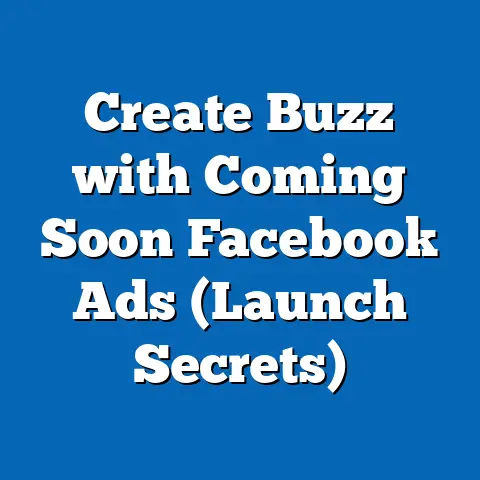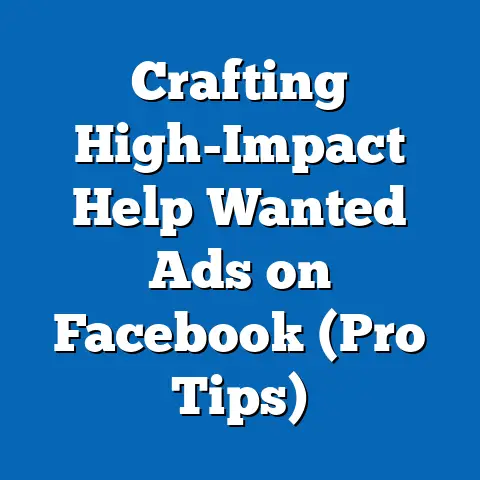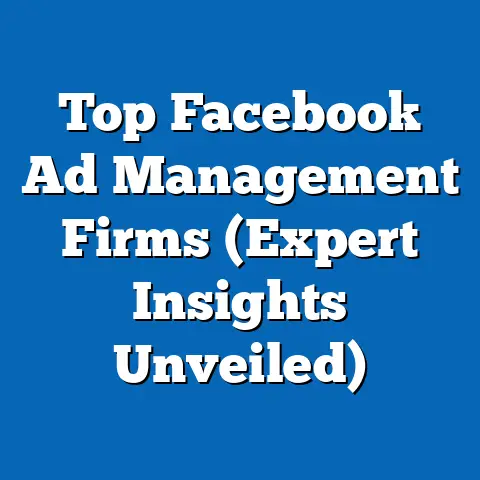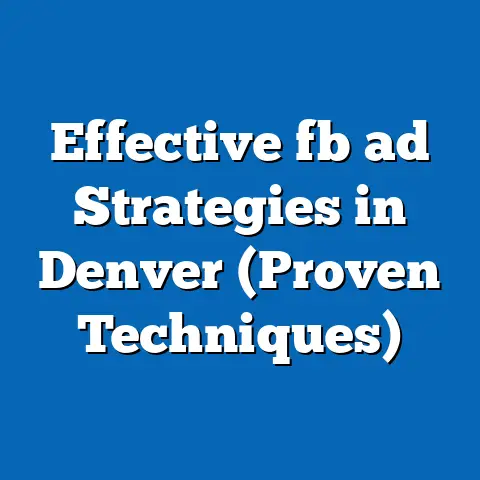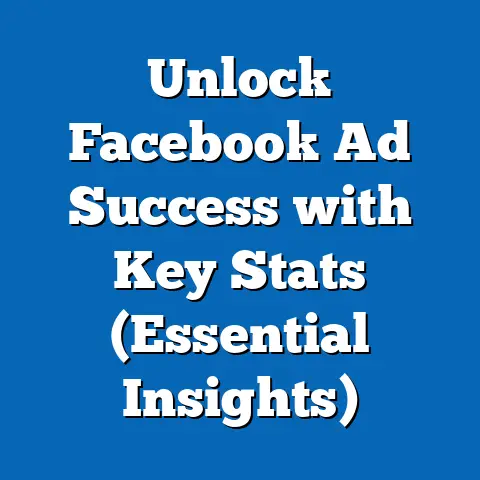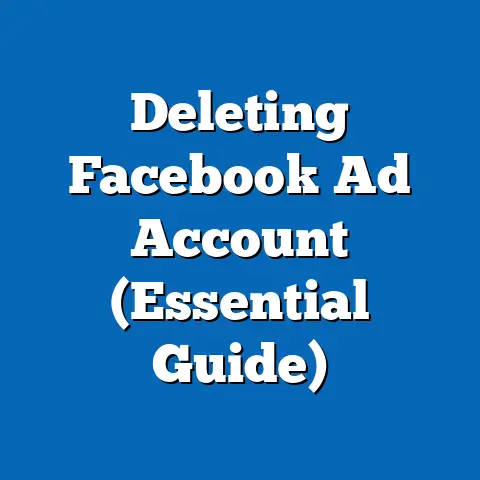Master Facebook Ads with Billy Gene’s Secrets (Expert Insights)
The digital landscape is a constantly shifting battlefield, and in the trenches of online marketing, few weapons are as powerful as Facebook Ads. I’ve seen firsthand how a well-crafted campaign can transform a struggling business into a thriving one, reaching audiences previously unimaginable. But let’s be honest, navigating the complexities of Facebook Ads Manager can feel like trying to decipher ancient hieroglyphics. That’s where the wisdom of experts like Billy Gene Shaw comes in. He isn’t just another marketing guru; he’s a master storyteller who understands the pulse of today’s consumer.
Let’s jump in and unlock the secrets to Facebook Ads success!
Understanding Facebook Ads
Before we dive into Billy Gene’s specific strategies, it’s crucial to establish a solid foundation by understanding the fundamentals of Facebook Ads. What exactly are they, and why are they so important?
What are Facebook Ads?
Simply put, Facebook Ads are paid advertisements that appear on Facebook and its related platforms, including Instagram, Messenger, and the Audience Network. These ads are designed to reach specific target audiences based on a variety of factors, such as demographics, interests, behaviors, and more.
Why are they important?
- Reach: Facebook boasts billions of active users, making it an unparalleled platform for reaching a massive audience.
- Targeting: Facebook’s advanced targeting capabilities allow you to pinpoint your ideal customer with incredible accuracy. I remember one campaign where we targeted users who had recently purchased a specific type of running shoe. The results were astounding!
- Measurable Results: Facebook provides detailed analytics, allowing you to track your ad performance and make data-driven decisions.
- Cost-Effectiveness: Compared to traditional advertising methods, Facebook Ads can be a much more cost-effective way to reach your target audience.
- Brand Building: Beyond direct sales, Facebook Ads can also be used to build brand awareness and foster customer loyalty.
Overview of Facebook’s Advertising Platform
Facebook’s advertising platform is a complex ecosystem with a wide array of options and features. Let’s break down some of the key components:
-
Ad Types: Facebook offers a variety of ad types to suit different marketing goals.
- Image Ads: Simple and effective, image ads are a great way to showcase your product or service.
- Video Ads: Video ads are highly engaging and can be used to tell a story or demonstrate a product in action. I’ve found that short, attention-grabbing videos tend to perform best.
- Carousel Ads: Carousel ads allow you to display multiple images or videos in a single ad unit, perfect for showcasing a range of products or features.
- Collection Ads: Collection ads are designed for e-commerce businesses, allowing users to browse and purchase products directly from the ad.
- Lead Ads: Lead ads make it easy for users to submit their contact information without leaving Facebook, ideal for generating leads for your business.
- Instant Experience Ads: These are full-screen, mobile-optimized experiences that open when someone clicks on your ad. They are great for immersive storytelling and showcasing your brand.
-
Ad Formats: Within each ad type, you have different formats to choose from, such as:
-
Single Image/Video: A standard ad format featuring a single image or video.
- Slideshow: A looping video created from a series of images.
- Canvas: An interactive ad format that allows users to explore content in a full-screen environment.
- Instant Articles: Mobile-optimized articles that load quickly on Facebook.
-
Campaign Objectives: When creating a Facebook Ad campaign, you’ll need to choose a campaign objective that aligns with your marketing goals. Some common objectives include:
-
Awareness: Reach as many people as possible in your target audience.
- Traffic: Drive traffic to your website or landing page.
- Engagement: Increase engagement on your Facebook page or posts.
- Leads: Generate leads for your business.
- Sales: Drive sales of your products or services.
- App Installs: Encourage users to download your app.
Ad Types: Facebook offers a variety of ad types to suit different marketing goals.
- Image Ads: Simple and effective, image ads are a great way to showcase your product or service.
- Video Ads: Video ads are highly engaging and can be used to tell a story or demonstrate a product in action. I’ve found that short, attention-grabbing videos tend to perform best.
- Carousel Ads: Carousel ads allow you to display multiple images or videos in a single ad unit, perfect for showcasing a range of products or features.
- Collection Ads: Collection ads are designed for e-commerce businesses, allowing users to browse and purchase products directly from the ad.
- Lead Ads: Lead ads make it easy for users to submit their contact information without leaving Facebook, ideal for generating leads for your business.
- Instant Experience Ads: These are full-screen, mobile-optimized experiences that open when someone clicks on your ad. They are great for immersive storytelling and showcasing your brand.
-
Ad Formats: Within each ad type, you have different formats to choose from, such as:
-
Single Image/Video: A standard ad format featuring a single image or video.
- Slideshow: A looping video created from a series of images.
- Canvas: An interactive ad format that allows users to explore content in a full-screen environment.
- Instant Articles: Mobile-optimized articles that load quickly on Facebook.
-
Campaign Objectives: When creating a Facebook Ad campaign, you’ll need to choose a campaign objective that aligns with your marketing goals. Some common objectives include:
-
Awareness: Reach as many people as possible in your target audience.
- Traffic: Drive traffic to your website or landing page.
- Engagement: Increase engagement on your Facebook page or posts.
- Leads: Generate leads for your business.
- Sales: Drive sales of your products or services.
- App Installs: Encourage users to download your app.
Ad Formats: Within each ad type, you have different formats to choose from, such as:
Single Image/Video: A standard ad format featuring a single image or video.
Campaign Objectives: When creating a Facebook Ad campaign, you’ll need to choose a campaign objective that aligns with your marketing goals. Some common objectives include:
Awareness: Reach as many people as possible in your target audience.
The Significance of Targeting in Facebook Ads
Targeting is the heart and soul of Facebook advertising. It’s what allows you to reach the right people with the right message at the right time. Facebook offers a wide range of targeting options, including:
- Demographics: Target users based on age, gender, location, education, and more.
- Interests: Target users based on their interests and hobbies.
- Behaviors: Target users based on their online behavior, such as purchase history and website activity.
- Custom Audiences: Create custom audiences based on your existing customer data, such as email lists or website visitors. I once uploaded a customer list and was amazed at how accurately Facebook matched those individuals to their profiles.
- Lookalike Audiences: Create lookalike audiences based on your existing custom audiences, allowing you to reach new people who are similar to your best customers.
The Facebook Ads Manager
The Facebook Ads Manager is your central hub for creating, managing, and analyzing your Facebook Ad campaigns. It’s a powerful tool that provides a wealth of information about your ad performance, allowing you to make data-driven decisions to optimize your campaigns.
Key features of the Facebook Ads Manager include:
- Campaign Creation: Create new ad campaigns and set your campaign objectives, budget, and targeting options.
- Ad Set Management: Manage your ad sets, which are groups of ads that share the same targeting options and budget.
- Ad Creation: Create individual ads with compelling ad copy, visuals, and calls to action.
- Reporting and Analytics: Track your ad performance with detailed reports and analytics, including metrics such as impressions, clicks, conversions, and ROI.
- A/B Testing: Test different versions of your ads to see which ones perform best.
Takeaway: Understanding the fundamentals of Facebook Ads is essential for success. By mastering the different ad types, formats, targeting options, and the Facebook Ads Manager, you’ll be well-equipped to create effective campaigns that reach your target audience and achieve your marketing goals. Next, we’ll explore Billy Gene’s unique approach to Facebook advertising.
Billy Gene’s Approach to Facebook Ads
Now that we’ve covered the basics, let’s delve into the unique philosophy and perspective of Billy Gene Shaw. He’s not just another marketer; he’s a true innovator who has consistently pushed the boundaries of what’s possible with Facebook advertising.
Billy Gene’s Philosophy
Billy Gene’s approach to Facebook Ads is rooted in a few key principles:
- Authenticity: Be real and genuine in your ads. People can spot a fake a mile away, so it’s important to be yourself and let your personality shine through.
- Storytelling: Tell a compelling story that resonates with your target audience. People are drawn to stories, so use them to connect with your audience on an emotional level.
- Value: Provide value to your audience. Don’t just try to sell them something; offer them something of value, such as helpful information, entertainment, or inspiration.
- Entertainment: Make your ads entertaining. People are more likely to pay attention to ads that are funny, engaging, or thought-provoking.
- Data-Driven: Use data to inform your decisions. Don’t just guess what works; track your ad performance and make adjustments based on the data.
Key Principles
Let’s break down these principles in more detail:
- Authenticity: In a world of carefully curated online personas, authenticity is more important than ever. People are tired of seeing polished, perfect ads that feel inauthentic. They want to see real people with real stories. Billy Gene understands this, and he encourages his clients to be themselves in their ads. Don’t be afraid to show your flaws and imperfections. It’s what makes you human and relatable.
- Storytelling: Storytelling is a powerful tool for connecting with your audience on an emotional level. When you tell a story, you’re not just selling a product or service; you’re selling an experience. You’re inviting your audience to step into your world and see things from your perspective. Billy Gene is a master storyteller, and he uses this skill to create ads that are both engaging and persuasive.
- Value: People are bombarded with ads every day, so it’s important to make yours stand out by providing value to your audience. Don’t just try to sell them something; offer them something of value, such as helpful information, entertainment, or inspiration. When you provide value, you’re building trust with your audience, which makes them more likely to buy from you in the future.
- Entertainment: Let’s face it, most ads are boring. People are more likely to pay attention to ads that are funny, engaging, or thought-provoking. Billy Gene understands this, and he encourages his clients to make their ads as entertaining as possible. Don’t be afraid to be creative and experiment with different styles of humor.
- Data-Driven: In the world of digital marketing, data is king. You can’t just guess what works; you need to track your ad performance and make adjustments based on the data. Billy Gene is a big believer in data-driven decision-making, and he uses data to optimize his clients’ ad campaigns for maximum ROI.
Combining Creativity with Data-Driven Insights
Billy Gene doesn’t just rely on his gut feeling or intuition when it comes to Facebook advertising. He combines his creative genius with data-driven insights to create ads that are both engaging and effective.
How does he do this?
- He starts with a creative concept: Billy Gene is known for his creative and unconventional ad ideas. He’s not afraid to take risks and try new things.
- He uses data to inform his creative decisions: Before he launches a campaign, he researches his target audience to understand their interests, behaviors, and pain points. He then uses this information to inform his creative decisions.
- He tracks his ad performance: Once the campaign is launched, he closely monitors the ad performance, tracking metrics such as impressions, clicks, conversions, and ROI.
- He makes adjustments based on the data: If an ad isn’t performing well, he makes adjustments to the ad copy, visuals, or targeting options. He continues to tweak and optimize the campaign until it’s achieving the desired results.
Case Studies
To illustrate Billy Gene’s methodologies and their effectiveness, let’s take a look at a few case studies:
- The Dentist Who Went Viral: Billy Gene helped a local dentist create a series of humorous video ads that went viral on Facebook. The ads featured the dentist dancing and singing about dental hygiene. As a result of the campaign, the dentist’s practice saw a significant increase in new patients.
- The Fitness Trainer Who Generated Thousands of Leads: Billy Gene helped a fitness trainer create a lead generation campaign on Facebook. The campaign targeted people who were interested in weight loss and fitness. The ads offered a free workout guide in exchange for their contact information. As a result of the campaign, the fitness trainer generated thousands of leads and signed up dozens of new clients.
- The E-commerce Business That Increased Sales by 300%: Billy Gene helped an e-commerce business optimize their Facebook Ad campaigns. He analyzed their ad performance and made adjustments to their ad copy, visuals, and targeting options. As a result of the campaign, the e-commerce business increased their sales by 300%.
Takeaway: Billy Gene’s approach to Facebook Ads is all about being authentic, telling stories, providing value, making ads entertaining, and using data to inform decisions. By following his principles, you can create Facebook Ad campaigns that are both engaging and effective. Next, we’ll explore how to craft compelling ad content that resonates with your target audience.
Crafting Compelling Ad Content
Creating compelling ad content is crucial for capturing the attention of your target audience and driving results. It’s not enough to simply have a great product or service; you need to communicate its value in a way that resonates with your audience’s needs and desires. This is where the art of crafting compelling ad content comes into play.
Elements of Successful Ad Copy
The ad copy is the written text that accompanies your ad visuals. It’s your opportunity to communicate your message, highlight the benefits of your product or service, and persuade your audience to take action. Here are some key elements of successful ad copy:
- Headlines: Your headline is the first thing people will see, so it needs to be attention-grabbing and relevant to your target audience. Use strong verbs, numbers, and questions to pique their interest.
- Body Text: Your body text should expand on your headline and provide more details about your product or service. Focus on the benefits, not just the features. Explain how your product or service will solve your audience’s problems or make their lives better.
- Calls to Action: Your call to action (CTA) tells your audience what you want them to do next. Use clear and concise CTAs, such as “Learn More,” “Shop Now,” or “Sign Up.”
The Role of Visuals in Facebook Ads
Visuals play a critical role in Facebook Ads. In fact, studies have shown that ads with visuals are more likely to be noticed and remembered than ads without visuals.
Here’s why visuals are so important:
- They grab attention: In a crowded newsfeed, visuals are a great way to stand out and grab people’s attention.
- They communicate quickly: Visuals can communicate your message much faster than text. People can process images and videos much faster than they can read text.
- They evoke emotion: Visuals can evoke emotion and connect with your audience on a deeper level.
Actionable Tips for Creating Engaging Content
Here are some actionable tips on how to create engaging content that resonates with your target audience, inspired by Billy Gene’s techniques:
- Know your audience: Before you start writing your ad copy or creating your visuals, take the time to understand your target audience. What are their interests, behaviors, and pain points? What kind of language do they use? What kind of visuals do they respond to?
- Focus on the benefits: Don’t just list the features of your product or service; focus on the benefits. Explain how your product or service will solve your audience’s problems or make their lives better.
- Use strong visuals: Choose high-quality images and videos that are visually appealing and relevant to your target audience. Make sure your visuals are optimized for Facebook’s ad specifications.
- Write clear and concise copy: Use clear and concise language that is easy to understand. Avoid jargon and technical terms.
- Use a strong call to action: Tell your audience what you want them to do next. Use clear and concise CTAs, such as “Learn More,” “Shop Now,” or “Sign Up.”
- Be authentic: Be yourself and let your personality shine through. People can spot a fake a mile away, so it’s important to be genuine and relatable.
- Tell a story: Use storytelling to connect with your audience on an emotional level. Share your personal experiences or the experiences of your customers.
- Make it entertaining: Make your ads as entertaining as possible. Use humor, creativity, and unexpected twists to grab people’s attention.
The Importance of A/B Testing
A/B testing is the process of testing different versions of your ads to see which ones perform best. It’s an essential part of optimizing your Facebook Ad campaigns.
Here’s why A/B testing is so important:
- It helps you identify what works: A/B testing allows you to test different ad copy, visuals, and targeting options to see which ones resonate best with your audience.
- It helps you improve your ad performance: By identifying what works, you can improve your ad performance and drive better results.
- It helps you save money: By optimizing your ad campaigns, you can save money on your advertising costs and get a better return on your investment.
Takeaway: Creating compelling ad content is essential for capturing the attention of your target audience and driving results. By focusing on the benefits, using strong visuals, writing clear and concise copy, using a strong call to action, being authentic, telling stories, making it entertaining, and A/B testing your ads, you can create Facebook Ad campaigns that are both engaging and effective. Next, we’ll explore how to target your audience effectively using advanced targeting strategies.
Targeting Your Audience Effectively
Targeting is the cornerstone of successful Facebook advertising. You can have the most creative ad in the world, but if it’s shown to the wrong people, it’s essentially invisible. Billy Gene understands the power of precise targeting, and his strategies emphasize reaching the right people, not just more people.
Advanced Targeting Strategies
Beyond basic demographics and interests, Facebook offers a wealth of advanced targeting options that can help you reach your ideal customer with laser precision. Here are some of the most powerful strategies:
- Custom Audiences: Custom Audiences allow you to target people who have already interacted with your business, such as website visitors, email subscribers, or customers. I’ve personally seen incredible results using customer lists to create highly targeted campaigns. It’s like speaking directly to people who already know and trust you.
- Website Custom Audiences: Target people who have visited specific pages on your website. This is a great way to re-engage people who have shown interest in your products or services.
- Customer List Custom Audiences: Upload a list of your customers’ email addresses or phone numbers to target them on Facebook. This is a great way to promote new products or services to your existing customer base.
- Engagement Custom Audiences: Target people who have interacted with your Facebook page or ads, such as liking your page, commenting on your posts, or watching your videos.
- Lookalike Audiences: Lookalike Audiences allow you to reach new people who are similar to your existing customers. Facebook analyzes the characteristics of your Custom Audiences and finds other users who share those same characteristics. This is a powerful way to expand your reach and find new customers who are likely to be interested in your products or services.
- Value-Based Lookalike Audiences: Optimize your Lookalike Audiences based on customer value. Upload a list of your customers with their purchase values, and Facebook will create a Lookalike Audience of people who are similar to your highest-spending customers.
- Detailed Targeting Expansion: This feature allows Facebook to expand your targeting beyond your initial selections if it believes it can find more people who are likely to convert. Use this feature with caution, as it can sometimes lead to irrelevant traffic.
- Behavioral Targeting: Target users based on their online behavior, such as purchase history, device usage, and travel habits. For example, you could target people who have recently purchased a new car or who are planning a vacation.
- Layered Targeting: Combine multiple targeting options to create a highly specific audience. For example, you could target women aged 25-34 who are interested in yoga and live in New York City.
- Website Custom Audiences: Target people who have visited specific pages on your website. This is a great way to re-engage people who have shown interest in your products or services.
- Customer List Custom Audiences: Upload a list of your customers’ email addresses or phone numbers to target them on Facebook. This is a great way to promote new products or services to your existing customer base.
- Engagement Custom Audiences: Target people who have interacted with your Facebook page or ads, such as liking your page, commenting on your posts, or watching your videos.
- Value-Based Lookalike Audiences: Optimize your Lookalike Audiences based on customer value. Upload a list of your customers with their purchase values, and Facebook will create a Lookalike Audience of people who are similar to your highest-spending customers.
The Importance of Audience Research and Segmentation
Before you start creating your Facebook Ad campaigns, it’s essential to conduct thorough audience research and segmentation. You need to understand who your ideal customer is, what their interests are, what their pain points are, and where they spend their time online.
Here are some tips for conducting audience research:
- Analyze your existing customer data: Look at your customer demographics, purchase history, and website behavior to identify trends and patterns.
- Conduct surveys and interviews: Ask your customers about their interests, needs, and preferences.
- Use Facebook Audience Insights: Facebook Audience Insights is a free tool that provides valuable insights into the demographics, interests, and behaviors of your target audience.
- Monitor social media: Pay attention to what people are saying about your brand and your competitors on social media.
Once you have a good understanding of your target audience, you can segment them into smaller groups based on their characteristics and needs. This will allow you to create more targeted and relevant ad campaigns.
Using Facebook’s Lookalike Audiences and Custom Audiences
As mentioned earlier, Lookalike Audiences and Custom Audiences are two of the most powerful targeting tools available on Facebook. Here are some tips for using them effectively:
- Start with high-quality data: The more accurate and complete your data, the better your Lookalike Audiences will perform.
- Segment your audiences: Create separate Lookalike Audiences for different segments of your customer base.
- Test different audience sizes: Experiment with different Lookalike Audience sizes to see which one performs best.
- Use value-based Lookalike Audiences: If you have customer data with purchase values, use value-based Lookalike Audiences to target people who are similar to your highest-spending customers.
- Refresh your audiences regularly: As your customer base grows and changes, it’s important to refresh your Lookalike Audiences and Custom Audiences regularly to ensure they remain accurate.
Analyzing Audience Engagement
It’s not enough to simply target your audience; you also need to analyze how they’re engaging with your ads. Are they clicking on your ads? Are they watching your videos? Are they converting into customers?
Here are some metrics to track:
- Click-Through Rate (CTR): The percentage of people who see your ad and click on it.
- Cost Per Click (CPC): The amount you pay each time someone clicks on your ad.
- Conversion Rate: The percentage of people who click on your ad and then complete a desired action, such as making a purchase or filling out a form.
- Return on Ad Spend (ROAS): The amount of revenue you generate for every dollar you spend on advertising.
By tracking these metrics, you can identify which ads are performing well and which ones need improvement. You can then use this information to adjust your targeting strategies and optimize your campaigns for maximum ROI.
Takeaway: Effective targeting is crucial for Facebook advertising success. By leveraging advanced targeting strategies, conducting thorough audience research, and analyzing audience engagement, you can reach the right people with the right message at the right time and drive better results.
Analyzing and Optimizing Campaign Performance
Creating a great Facebook Ad campaign is only half the battle. The other half is analyzing its performance and making adjustments to optimize it for maximum ROI. Billy Gene emphasizes the importance of data-driven decision-making, and his approach to campaign optimization is no exception.
Metrics That Matter
There are a plethora of metrics available in Facebook Ads Manager, but not all of them are created equal. Here are some of the most important metrics to focus on:
- Impressions: The number of times your ad was shown to people.
- Reach: The number of unique people who saw your ad.
- Click-Through Rate (CTR): The percentage of people who saw your ad and clicked on it. A high CTR indicates that your ad copy and visuals are resonating with your target audience.
- Cost Per Click (CPC): The amount you pay each time someone clicks on your ad. A low CPC indicates that your ads are efficient and cost-effective.
- Cost Per Mille (CPM): The amount you pay for 1,000 impressions. CPM is a good metric for measuring the overall cost of your campaign.
- Conversion Rate: The percentage of people who click on your ad and then complete a desired action, such as making a purchase or filling out a form. A high conversion rate indicates that your landing page and offer are compelling.
- Cost Per Acquisition (CPA): The amount you pay for each conversion. CPA is a good metric for measuring the overall effectiveness of your campaign.
- Return on Ad Spend (ROAS): The amount of revenue you generate for every dollar you spend on advertising. ROAS is the ultimate metric for measuring the profitability of your campaign.
Interpreting Facebook Ads Insights
Facebook Ads Insights provides a wealth of information about your ad performance, including demographics, interests, behaviors, and more. It’s important to understand how to interpret this data so you can make informed decisions about your campaigns.
Here are some tips for interpreting Facebook Ads Insights:
- Look at the demographics of your audience: Are you reaching the right people? Are there any unexpected demographics that are performing well?
- Analyze the interests of your audience: What are their interests and hobbies? Are there any new interests that you should be targeting?
- Track the behaviors of your audience: What are their online behaviors? Are they purchasing your products or services? Are they engaging with your content?
- Compare your results to industry benchmarks: Are your CTR, CPC, and conversion rates in line with industry averages? If not, what can you do to improve them?
- Look for trends and patterns: Are there any trends or patterns in your data that you can use to optimize your campaigns?
Billy Gene’s Tactics for Ongoing Optimization
Billy Gene is a master of ongoing optimization, and he uses a variety of tactics to improve his clients’ ad campaigns. Here are some of his key strategies:
- A/B Testing: Continuously test different versions of your ads to see which ones perform best. Test different ad copy, visuals, targeting options, and calls to action.
- Audience Refinement: Regularly refine your targeting options to ensure you’re reaching the right people. Exclude audiences that are not performing well and add new audiences that are showing promise.
- Budget Optimization: Adjust your budget based on ad performance. Allocate more budget to ads that are performing well and less budget to ads that are not.
- Landing Page Optimization: Optimize your landing page to improve conversion rates. Make sure your landing page is relevant to your ad copy and visuals, and that it’s easy for people to convert.
- Creative Refresh: Regularly refresh your ad creative to keep your audience engaged. Use new images, videos, and ad copy to keep your ads fresh and interesting.
- Analyze the Customer Journey: Understand the entire customer journey, from the moment someone sees your ad to the moment they become a customer. Identify any bottlenecks or pain points in the customer journey and address them.
Key Performance Indicators (KPIs) for Continuous Improvement
To ensure you’re on track for success, it’s important to focus on key performance indicators (KPIs) that align with your marketing goals. Here are some KPIs to consider:
- Website Traffic: If your goal is to drive traffic to your website, track metrics such as website visits, page views, and bounce rate.
- Lead Generation: If your goal is to generate leads, track metrics such as lead form submissions, cost per lead, and lead quality.
- Sales: If your goal is to drive sales, track metrics such as revenue, conversion rate, and return on ad spend.
- Brand Awareness: If your goal is to build brand awareness, track metrics such as reach, impressions, and engagement.
By tracking these KPIs, you can monitor your progress and make adjustments to your campaigns as needed.
Takeaway: Analyzing and optimizing campaign performance is an ongoing process. By focusing on the metrics that matter, interpreting Facebook Ads Insights, and implementing Billy Gene’s optimization tactics, you can continuously improve your ad campaigns and drive better results.
Conclusion
Throughout this guide, we’ve explored the world of Facebook Ads through the lens of Billy Gene’s unique and effective strategies. We’ve covered the fundamentals of Facebook advertising, delved into Billy Gene’s key principles, and provided actionable tips to create compelling ad content, target your audience with laser precision, and continuously optimize your campaigns for maximum ROI. I’ve shared my own experiences and insights along the way, hoping to illuminate the path to Facebook Ads success for you.
It’s important to remember that Facebook advertising is a dynamic and ever-evolving landscape. What works today may not work tomorrow, so it’s essential to stay up-to-date with the latest trends and best practices. By embracing Billy Gene’s principles of authenticity, storytelling, value, entertainment, and data-driven decision-making, you can create Facebook Ad campaigns that are both engaging and effective, and that resonate with the lifestyle needs of modern consumers.
The key to success in Facebook advertising is to never stop learning, never stop testing, and never stop optimizing. Embrace the challenge, be creative, and don’t be afraid to experiment. With the right strategies and insights, you can unlock the full potential of Facebook Ads and achieve your marketing goals.
Call to Action
Ready to take your Facebook Ads to the next level? I encourage you to explore more resources on Facebook advertising and to consider following Billy Gene’s work for ongoing inspiration and education in digital marketing. Join relevant Facebook groups or forums to network with other marketers and share your experiences. The world of Facebook Ads is vast and complex, but with dedication, perseverance, and a willingness to learn, you can achieve remarkable results.
Now go out there and create some amazing Facebook Ad campaigns! The digital landscape awaits your creativity and innovation.

